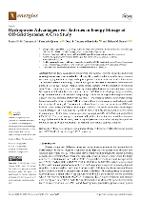Abstract
Microgrids are decentralized power production systems, where the energy production and consumption are very close to each other. Microgrids generally exploit renewable energy sources, encountering a problem of storage, as the power production from solar and wind is intermittent. This research presents a new integrated methodology and discusses a comparison of batteries and pumped storage hydropower (PSH) as energy storage systems with the integration of wind and solar PV energy sources, which are the major upcoming technologies in the renewable energy sector. We implemented the simulator and optimizer model (HOMER), which develops energy availability usage to obtain optimized renewable energy integration in the microgrid, showing its economic added value. Two scenarios are run with this model—one considers batteries as an energy storage technology and the other considers PSH—in order to obtain the best economic and technical results for the analyzed microgrid. The economic analysis showed a lower net present cost (NPC) and levelized cost of energy (LCOE) for the microgrid with PSH. The results showed that the microgrid with the storage of PSH was economical, with an NPC of 45.8 M€ and an LCOE of 0.379 €/kWh, in comparison with the scenario with batteries, which had an NPC of 95.2 M€ and an LCOE of 0.786 €/kWh. The role of storage was understood by differentiating the data into different seasons, using a Python model. Furthermore, a sensitivity analysis was conducted by varying the capital cost multiplier of solar PV and wind turbines to obtain the best optimal economic solutions.














